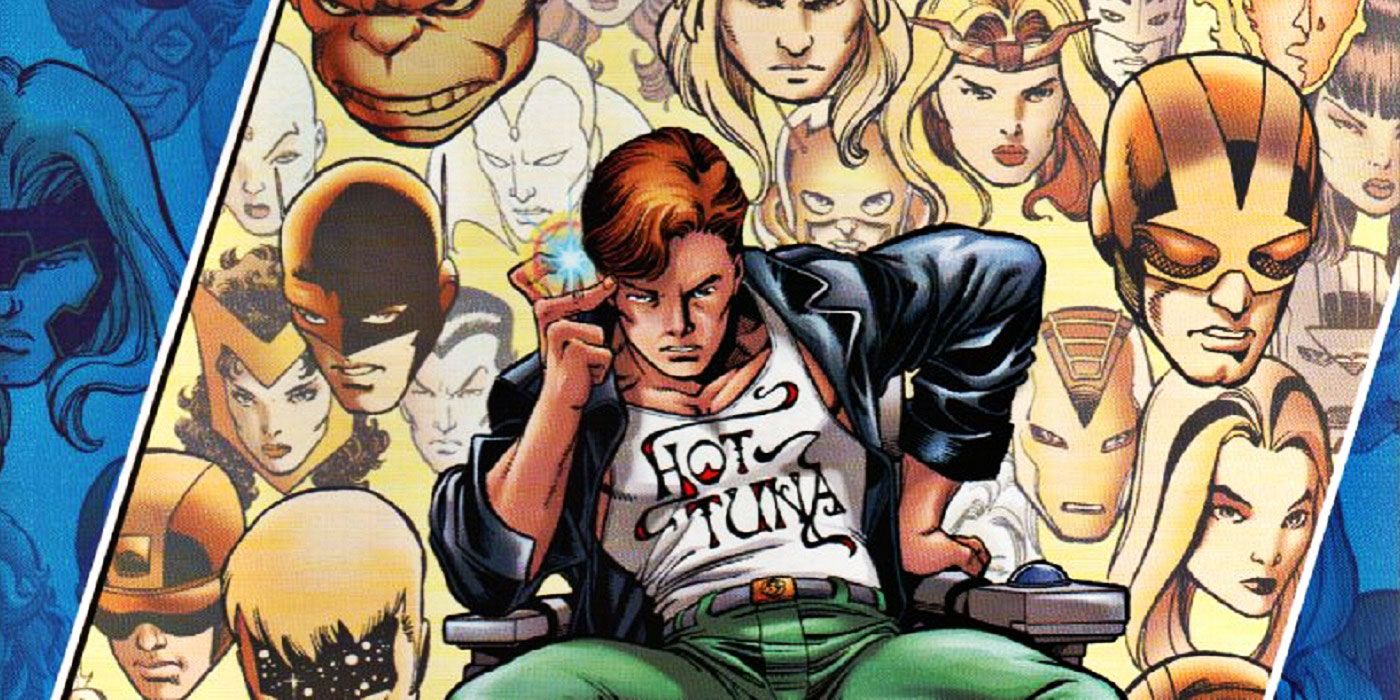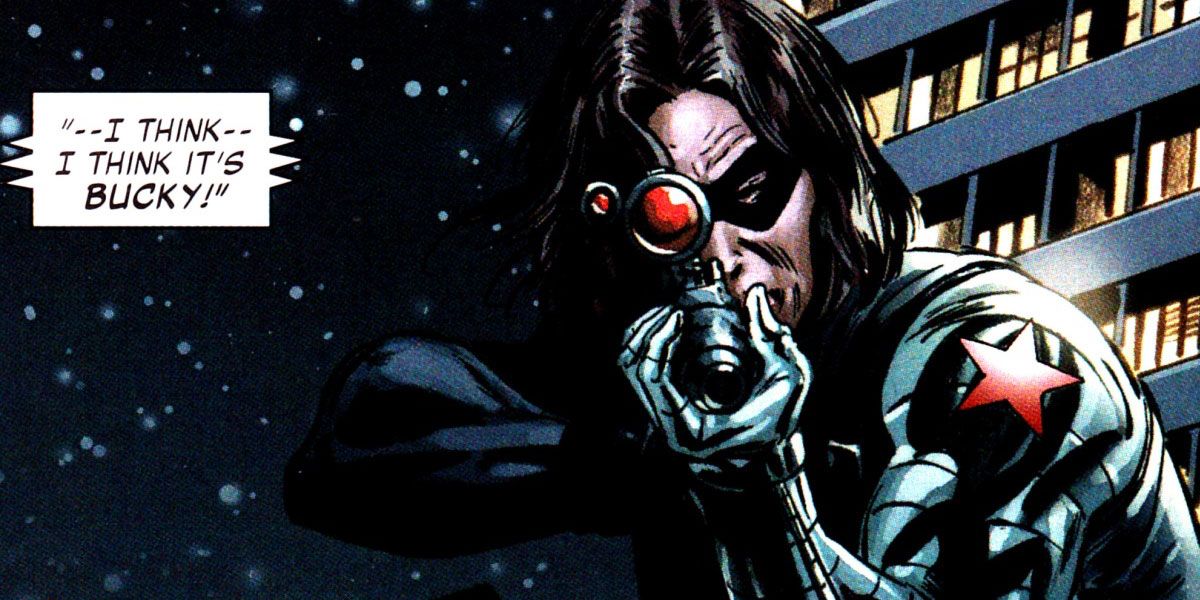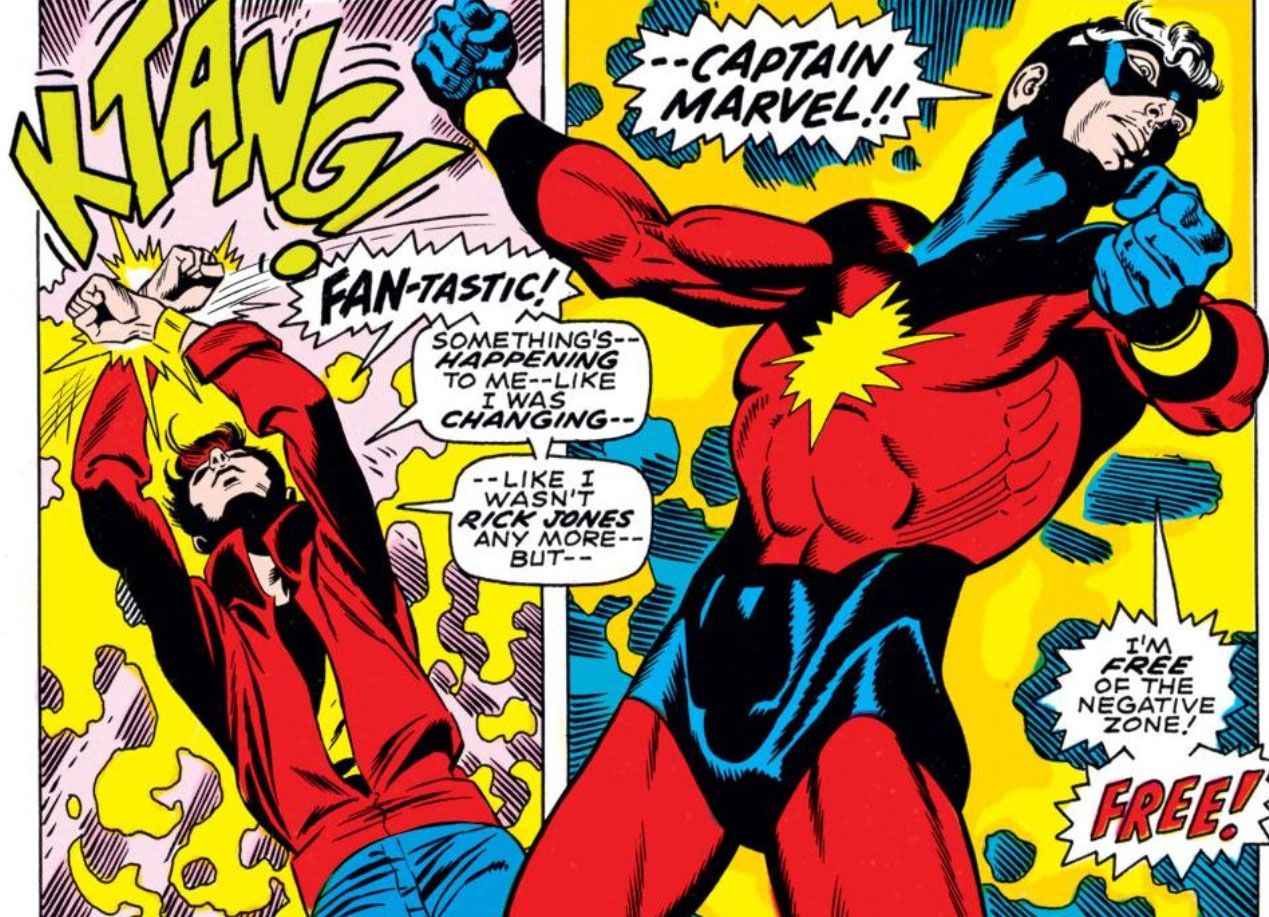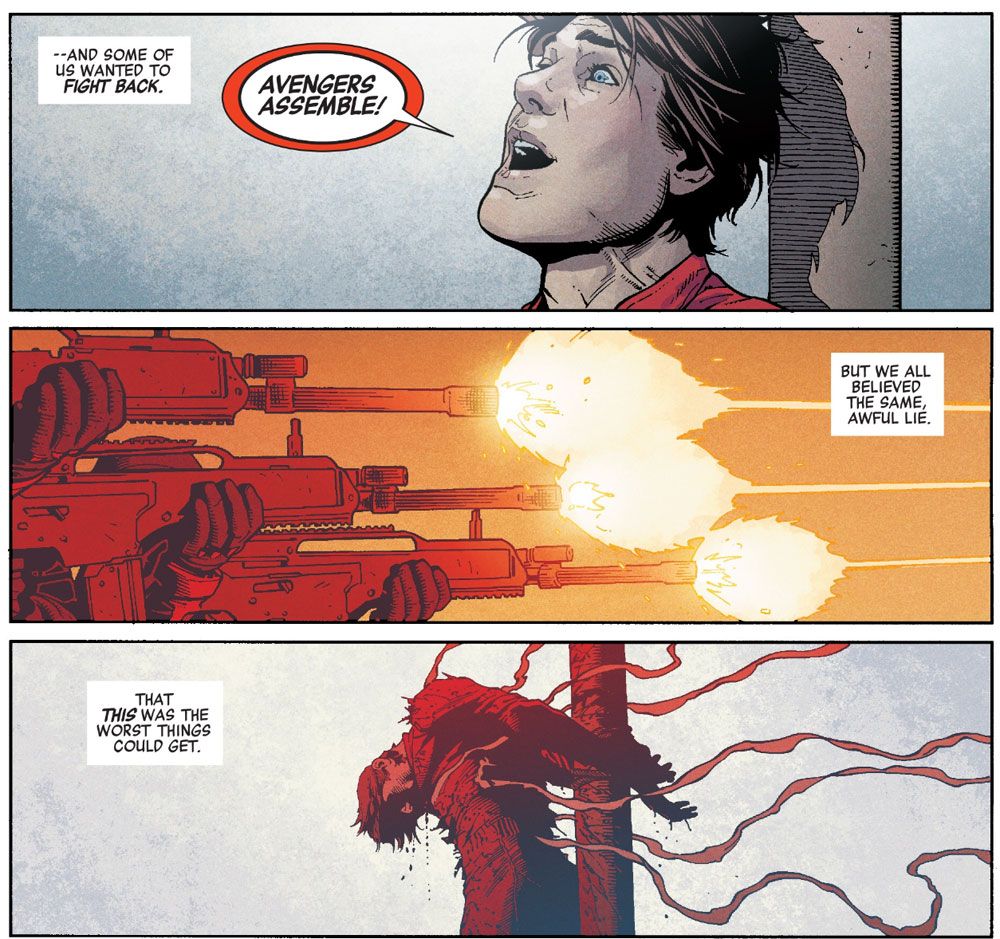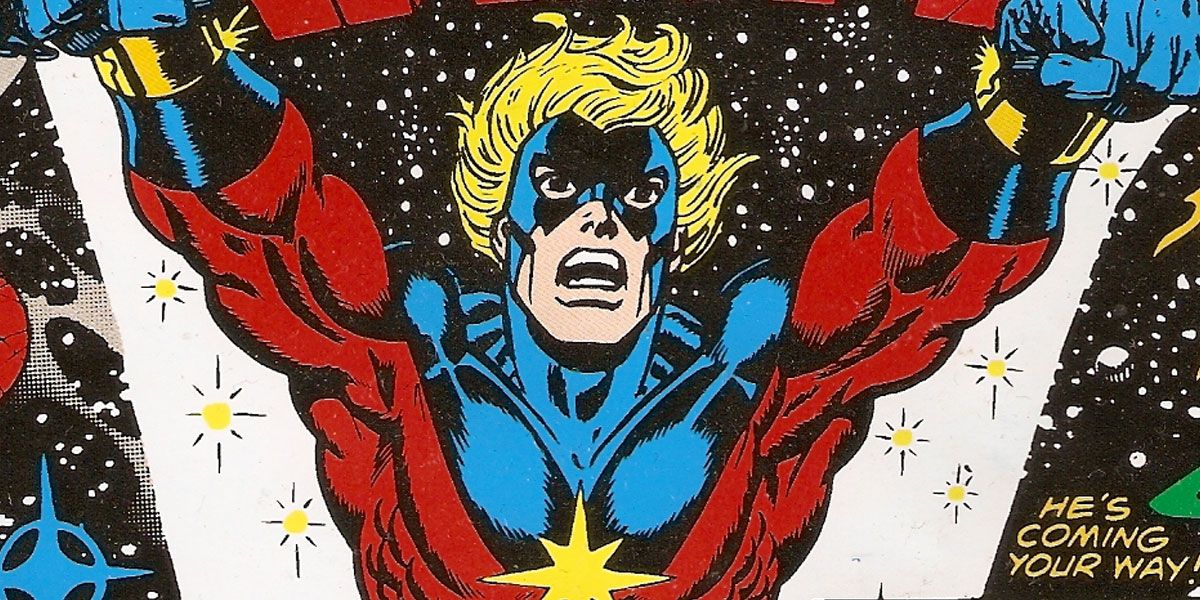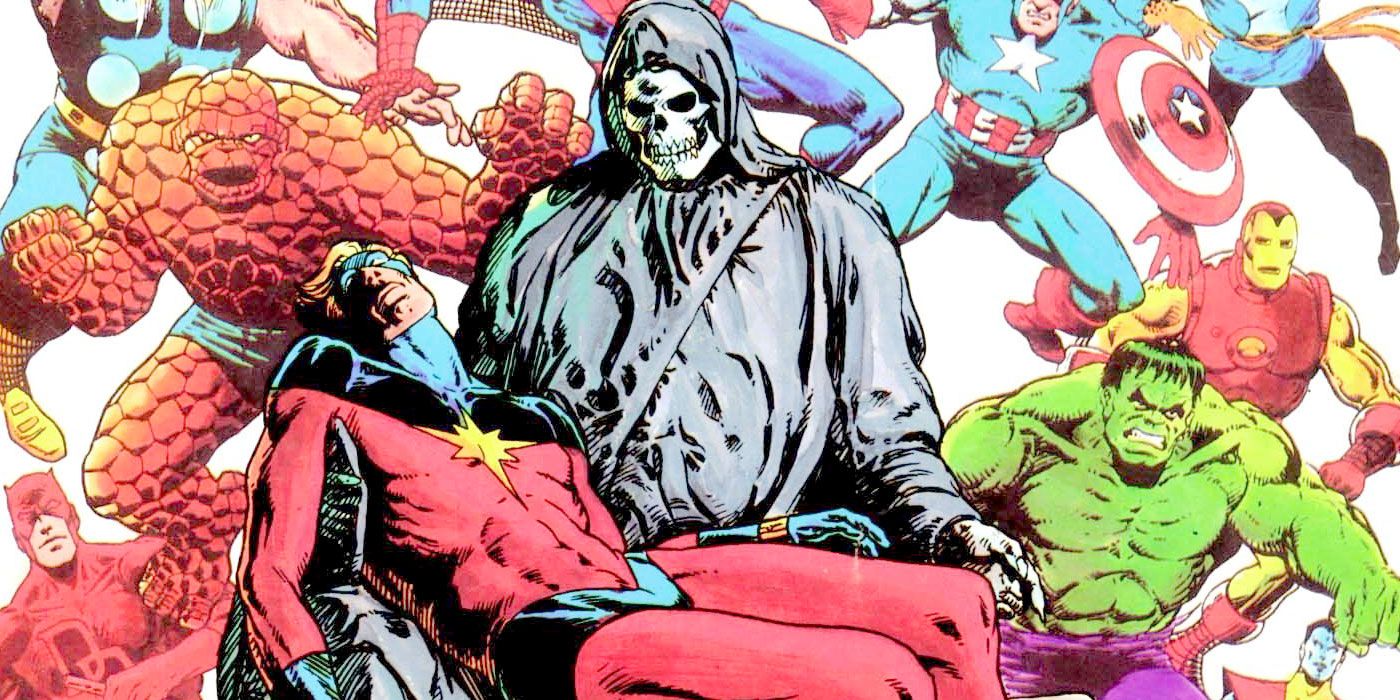Nobody stays dead in comics.
That’s the conventional wisdom, at least, but some characters have remained dead for a very long time. One such character was Captain America sidekick Bucky Barnes, who bit the dust on a drone over the Arctic at the end of World War II. Ironically, Bucky’s fate did not in fact happen in the pages of the original “Captain America” comic book, but was reported as part of a retcon, decades after the fact.
When Stan Lee and Jack Kirby thawed Captain America out of the ice in 1963’s “The Avengers” #4, Steve Rogers had an immediate freakout upon recalling the death of his youthful comrade. Lee reportedly hated the trope ion the teenage sidekick, and this contrivance was a quick way of getting rid of Bucky. But the plot point stuck, and Barnes stayed dead for over four decades, until Ed Brubaker brought him back as the Winter Soldier during his legendary Captain America run.
This second retcon revealed that Bucky had survived the crash, but had lost an arm in the process. He had then been captured by the Soviets, who gave him a mechanical limb and who brainwashed him into becoming a super-stealthy assassin. Like his mentor Steve, Bucky had also been frozen, but purposefully, to be thawed intermittently so he could dispatch of the enemies of the U.S.S.R. It was one of the most compelling rebirths in the history of comics. Bucky not only went on defeat his Soviet programming, he eventually carried the shield, becoming Captain America after Steve Rogers was apparently killed at the end of the first superhero civil war.
In an echo of his initial demise, Barnes died again in the lead-up to the current “Secret Empire” event, which saw Helmut Zemo strap the one-time Winter Soldier to a drone plane and launch him to a fiery death, payback for Bucky killing his father in World War II.
At the end of “Secret Empire” #1, we witnessed the death of another longtime Captain America confederate when Rick Jones was executed by firing squad for stealing Hydra secrets and sharing them with the resistance. Jones, who has a reputation as Marvel’s perennial sidekick, briefly wore the mantle of Bucky in the late 1960s, and more recently had become a hacker known as the Whisperer. In fact, it was Jones who discovered S.H.I.E.L.D.’s secret prison at Pleasant Hill, and alerted the depowered and aged Steve Rogers to its existence, thus setting off the chain of events that would lead to “Secret Empire.”
On the surface, Pleasant Hill was a small town in Connecticut, but it was in fact a high-security prison surrounded by an invisible StarkTech force field, home to some of the most dangerous villains in the Marvel Universe. But its inmates did not know where, or even who they were. S.H.I.E.L.D. director Maria Hill had used Kobik, a sentient Cosmic Cube who had taken on the form of a four year-old girl, to manipulate the super villains' realities, effectively transforming them into ordinary citizens living mundane lives in a quiet hamlet.
Of course, things didn’t go quite as planned, and chaos ensued once the villains realized what had happened. In the midst of the battle for Pleasant Hill, Kobik restored Rogers, who hd previously been aged into an older, geriatric hero, to his youthful, super soldier serum-enhanced self -- but in doing so, she also gave him a new origin, rewriting his history so he had aways been a double agent working for Hydra. The entire hidden prison scheme turned out to be a ruse concocted by the Red Skull as a means of striking at Rogers, and as a way of turning Captain America into the very thing he’d fought his entire life.
But the Skull himself ended up double-crossed. Kobik not so much created a reality in which Rogers had always worked for Hydra, but restored one. In “Secret Empire” #0, we learned that the Allies had in fact lost World War II. In a last ditch effort to reverse their fortunes, they created the first Cosmic Cube, and used its powers to alter the course of history, thus emerging victorious. Rogers' true fate at the end of the war was to voluntarily end up frozen so that he could be revived in the future, where he would restore Hydra to its proper glory -- and defeat its usurper, the Red Skull.
RELATED: Who is the Most Fascinating Man in the Marvel Universe?
Rick’s position as the Whisperer put him at the front and center of the Marvel Universe once again, and also echoed one of his earliest roles, as the leader of the Teen Brigade. Feeling responsible for the accident that had caused Bruce Banner to mutate into the Incredible Hulk, Jones assembled a group of amateur radio enthusiasts to monitor and send transmissions that would prevent trouble for the Green Goliath. In the days before the widespread adoption of computers and the proliferation of the Internet, Rick and his fellow “ham” radio operators were a lower-tech version of todays hackers.
Here's where it all gets really interesting.
Despite his many adventures throughout the years, Jones’ greatest claim to fame remains his stint as a sidekick to the original Captain Marvel, the Kree Warrior, Mar-Vell. His most glorious moment in this capacity occurred on the Kree Homeworld of Hala, when Rick singlehandedly saved the universe using only the powers of his mind, and dying in the process.
It happened in the pages of “The Avengers” #97, during the conclusion of “The Kree-Skrull War,” a nine-issue story arc that was a precursor to Marvel’s present day events. Ronan the Accuser, a Kree judicial official, had usurped power and imprisoned the Supreme Intelligence (aka Supremor), the rightful leader of the empire. Jones became an unwitting pawn in the final battle between the two when Supremor forced him into the Negative Zone to battle Annihilus, the sole inhabitant of that alternate dimension. It was a desperate gambit by the Kree leader to force Jones into a fight or flight situation that would activate the vast mental powers inherent in all humans.
Supremor’s ploy worked. Using only his mind, Jones created a powerful energy beam that repelled Annihilus and enabled him to navigate away from one of the Negative Zone’s explosive regions, thus avoiding certain death. Having proved the extent of his powers, Jones was recalled by the Supreme Intelligence for a final confrontation with Ronan and his forces.
At the beckoning of Supremor, Jones reached into his mind and brought to life an array of characters from the Golden Age of Comics. These heroes from the pages of Marvel’s predecessor, Timely Comics—Captain America, the Sub-Mariner and the Human Torch from the wartime All-Winners team, as well as the original Patriot and Vision—duked it out with Ronan’s forces, but this was not the true battlefront. Reaching into the furthest reaches of intergalactic space, and using Mar-Vell as a relay, Rick’s mental powers froze the invading Skrull armada en route to Earth, and also exposed the agitating anti-Alien U.S. Senator Craddock as a shapeshifter.
But the effort was too great for Jones, and Captain Marvel once again bonded molecularly with the youth in order to resuscitate him.
There are some striking parallels between Rick’s heroics at the conclusion of “The Kree-Skrull War” and his death in the pages of “Secret Empire #1.” In both cases, his heroism and sacrifice are the result of expanded mental powers. In the present day, Jones temporarily acquired the ability to learn anything at lightning speed as a result of losing his Hulk powers after his tenure as A-Bomb. This allowed him to master the use of computers, transforming him into the hacktivist known as the Whisperer. His revelation of the Pleasant Hill conspiracy echoes his unmasking of Craddock, but his death by firing squad has even more similarities with his actions in the pages of “The Avengers” #97.
Before he is led to his "Secret Empire" death, Rick tells Rogers he’s not going to give up hope because Captain America is his hero. As the bullets fly, he shouts “Avengers Assemble!” It is a last desperate cry for help and an act of defiance. But is this also a call-out to his universe-saving actions in the pages of “The Kree-Skrull War?” As he shouts out for his superpowered cohorts to save him, is this an echo of his bringing to life his childhood heroes in that earlier story?
The circumstances are remarkably similar. A so-called agent of justice—Ronan the Accuser in the past, and Captain America in the present—has usurped power, and war has broken out on multiple fronts. Jones is called upon once again to make the ultimate sacrifice, but does not survive. Also, in an inversion of the “Kree-Skrull War,” Rogers, the usurper, is called the Supreme Leader, and is in charge of an organization whose symbol is a many-tentacled green head. Whereas Supremor, the deposed Kree Supreme Intelligence was in fact a many-tentacled green head. This parallel may be incidental or even coincidental, but are such things ever in comics?
Is Nick Spencer deliberately referencing “The Kree-Skrull War” in “Secret Empire?” If this is, as stated, Marvel’s last major event for a while, there is poetic symmetry in hearkening back to the storyline that got the ball rolling. But what if there’s something else afoot? What if Spencer is about to pull off the biggest character reincarnation since Bucky’s return as the Winter Soldier?
Is “Secret Empire” going to retcon “The Death of Captain Marvel?”
Few characters have remained dead as long as Mar-Vell has. Co-created by Stan Lee and Gene Colan in 1967, Captain Marvel started off a generic hero designed to capitalize on a lapsed trademark after DC Comics sued Fawcett Comics out of existence. The character got a major facelift in 1969, when Gil Kane refitted him with his iconic red and black uniform, replacing Colan’s bland green and white space-soldier outfit, but the physical makeover wasn’t enough to entice readers, and the title was cancelled with the August 1970 issue (#21).
“Captain Marvel” was revived after the success of “The Kree-Skrull War,” but the character didn’t really come into his own until Jim Starlin took over the title in issue #25, and transformed Mar-Vell into the cosmically-aware champion of the universe. Despite Starlin’s cult status as a writer and artist, sales of the bi-monthly title were modest and it was cancelled in 1979. Starlin revisited the character in 1982 for one last time.
“The Death of Captain Marvel” was the first title in the “Marvel Graphic Novels” line, and told the story of the dying Kree Warrior. It was not a tale of heroism in the traditional superhero sense. Mar-Vell did not die in battle, rather he succumbed to cancer as a result of exposure to the deadly Compound 13 a decade earlier, in a confrontation in the exploding villain, Nitro. Despite the best efforts of the greatest human and extra-terrestrial minds in Marvel Universe, there was no cure for his ailment, and Mar-Vell died in bed on Saturn’s moon, Titan, surrounded by the superhero community.
To date, nobody has retconned this most somber of superhero deaths. A Skrull impersonator made an appearance at the tail end of the first “Civil War,” and Kree mystics used the Phoenix Force to briefly bring him back him during “Avengers vs. X-Men,” but in that last instance, he sacrificed himself to save his people. Carol Danvers, the current Captain Marvel, previously called herself Ms. Marvel, but she adopted his name in honor of this sacrifice.
But things may be about to change. Marvel Comics has already announced “Generations,” a series of ten one-offs that will follow “Secret Empire,” and which will pair so-called legacy heroes like Carol Danvers with their original Marvel counterparts. Marvel’s Axel Alonso has already said that these stories will not involve time travel or alternate realities, and will be canonical. For this to be true, Mar-Vell needs to be retconned into the post-“Secret Wars” Marvel Universe, and “Secret Empire” may be his ticket back.
The Hydra takeover is in full swing in the pages of “Secret Empire” #1. Reality has been warped by Kobik, and its hard to tell what’s what and who is who. Rick Jones is dead, as is the current Quasar, Avril Kincaid. Carol Danvers and the Alpha Flight are trapped in space. Barred from Earth by the very defense shield she championed, and facing wave after wave of invading Chitauri, Carol sends out a desperate plea for help, a cosmic distress signal. The Earth is in peril from within and in need of help from without.
If there ever was a time Mar-Vell to return, it's now. The Earth needs the original protector of the Marvel Universe.

